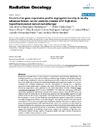Please use this identifier to cite or link to this item:
https://accedacris.ulpgc.es/handle/10553/9025
| Title: | Constitutive gene expression profile segregates toxicity in locally advanced breast cancer patients treated with high-dose hyperfractionated radical radiotherapy | Authors: | Henríquez Hernández, Luis Alberto Lara Jiménez, Pedro Carlos Pinar, Beatriz Bordón, Elisa Rodríguez-Gallego, Carlos Bilbao, Cristina Fernandez-Perez, Leandro Flores Morales, Amílcar |
UNESCO Clasification: | 320101 Oncología | Keywords: | Onto-Tools Ionizing-Radiation Dna-Damage Stage-Iii Design, et al |
Issue Date: | 2009 | Journal: | Radiation Oncology | Abstract: | Breast cancer patients show a wide variation in normal tissue reactions after radiotherapy. The individual sensitivity to x-rays limits the efficiency of the therapy. Prediction of individual sensitivity to radiotherapy could help to select the radiation protocol and to improve treatment results. The aim of this study was to assess the relationship between gene expression profiles of ex vivo un-irradiated and irradiated lymphocytes and the development of toxicity due to high-dose hyperfractionated radiotherapy in patients with locally advanced breast cancer. Raw data from microarray experiments were uploaded to the Gene Expression Omnibus Database http://www.ncbi.nlm.nih.gov/geo/ (GEO accession GSE15341). We obtained a small group of 81 genes significantly regulated by radiotherapy, lumped in 50 relevant pathways. Using ANOVA and t-test statistical tools we found 20 and 26 constitutive genes (0 Gy) that segregate patients with and without acute and late toxicity, respectively. Non-supervised hierarchical clustering was used for the visualization of results. Six and 9 pathways were significantly regulated respectively. Concerning to irradiated lymphocytes (2 Gy), we founded 29 genes that separate patients with acute toxicity and without it. Those genes were gathered in 4 significant pathways. We could not identify a set of genes that segregates patients with and without late toxicity. In conclusion, we have found an association between the constitutive gene expression profile of peripheral blood lymphocytes and the development of acute and late toxicity in consecutive, unselected patients. These observations suggest the possibility of predicting normal tissue response to irradiation in high-dose non-conventional radiation therapy regimens. Prospective studies with higher number of patients are needed to validate these preliminary results. | URI: | https://accedacris.ulpgc.es/handle/10553/9025 | ISSN: | 1748-717X | Other Identifiers: | http://dx.doi.org/10.1186/1748-717X-4-17 | DOI: | 10.1186/1748-717X-4-17 | Source: | Radiation Oncology[ISSN 1748-717X],v. 4 |
| Appears in Collections: | Artículos |
Show full item record
SCOPUSTM
Citations
28
checked on Jun 8, 2025
WEB OF SCIENCETM
Citations
21
checked on Jun 8, 2025
Page view(s)
96
checked on May 4, 2024
Download(s)
135
checked on May 4, 2024
Google ScholarTM
Check
Altmetric
Share
Export metadata
Items in accedaCRIS are protected by copyright, with all rights reserved, unless otherwise indicated.
